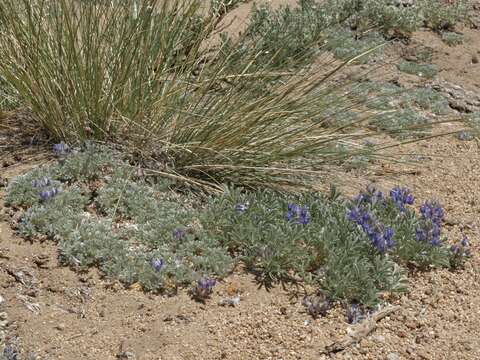Mono Lake lupine, Lupinus tegeticulatus var. duranii (17626042572)

Description:
Description: Mono Lake lupine, Lupinus tegeticulatus var. duranii (plant at right), next to a plant of var. tegeticulatus (left), White Mountains, elevation 3085 m (10115 ft). Distinctly more robust plants like the one at right turn up as occasional individuals (maybe 1 in every 200 or so) within this population of var. tegeticulatus, and are atypical of var. duranii only in maintaining the matted habit of var. tegeticulatus (versus tufted in var. duranii). No intermediates have been seen in the area, suggesting that this form may represent a rare allele (or possibly an occasional polyploid) in this population. If so, this could have been the source of genetic variation that eventually became fixed as populations of var. duranii (and possibly var. grandiflorus also) farther to the west. I follow Rupert Barneby's treatment in Intermountain Flora (1989, vol. 3B, p. 260) in recognizing the strictly acaulescent, mat or mound-forming Lupinus breweri var. bryoides (and its related varieties) as a distinct species from the rest of Lupinus breweri, which goes by the name Lupinus tegeticulatus. Also visible are Indian ricegrass (Stipa hymenoides) and mountain sagebrush (Artemisia tridentata ssp. vaseyana). Date: 24 June 2014, 11:41. Source: Mono Lake lupine, Lupinus tegeticulatus var. duranii. Author: Jim Morefield from Nevada, USA. Camera location37° 30′ 09.5″ N, 118° 10′ 16.46″ W View all coordinates using: OpenStreetMap 37.502638; -118.171239.
Included On The Following Pages:
- Life (creatures)
- Cellular (cellular organisms)
- Eukaryota (eukaryotes)
- Archaeplastida (plants)
- Chloroplastida (green plants)
- Streptophyta
- Embryophytes
- Tracheophyta (ferns)
- Spermatophytes (seed plants)
- Angiosperms (Dicotyledons)
- Eudicots
- Superrosids
- Rosids
- Fabales ("An order: peas, beans, and relatives")
- Fabaceae (legumes)
- Lupinus (Lupin)
- Lupinus breweri (Brewer's Lupine)
This image is not featured in any collections.
Source Information
- license
- cc-by-sa-3.0
- copyright
- Jim Morefield|sourceurl=https://flickr.com/photos/127605180@N04/17626042572%7Carchive=https://web.archive.org/web/20190116014824/https://www.flickr.com/photos/127605180@N04/17626042572/%7Creviewdate=2019-12-29 04:06:13|reviewlicense=cc-by-sa-2.0|reviewer=FlickreviewR 2
- creator
- Jim Morefield|sourceurl=https://flickr.com/photos/127605180@N04/17626042572%7Carchive=https://web.archive.org/web/20190116014824/https://www.flickr.com/photos/127605180@N04/17626042572/%7Creviewdate=2019-12-29 04:06:13|reviewlicense=cc-by-sa-2.0|reviewer=FlickreviewR 2
- source
- Jim Morefield (127605180@N04)
- original
- original media file
- visit source
- partner site
- Wikimedia Commons
- ID


